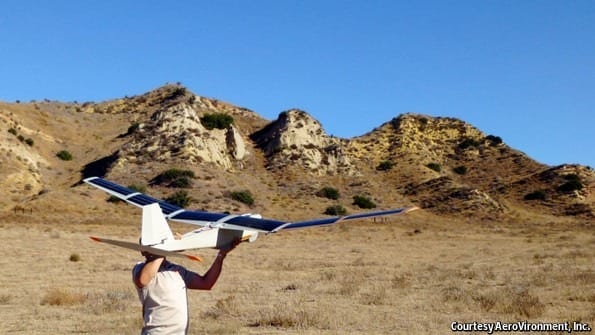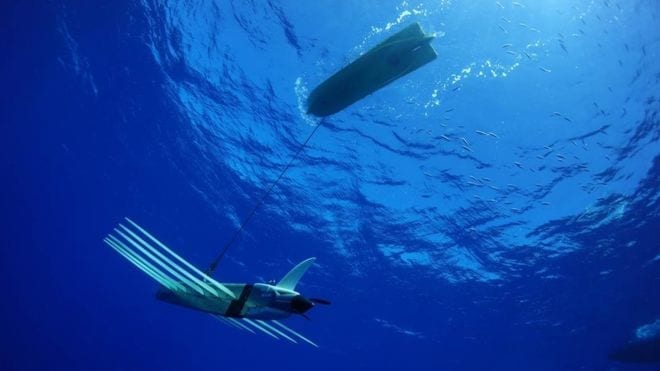Small, remote-controlled craft powered by the sun are taking to the air
FLYING using only the power of the sun is an enticing prospect. But manned solar-powered aircraft are fragile and slow, like the ungainly craft which a Swiss team called Solar Impulse plan to fly around the world. Take the weight of the pilot out, however, and things change. A solar-powered unmanned aerial system (a UAS, more commonly called a drone) could fly long, lonely missions that conventional aircraft would not be capable of. Advances with the technology mean many such craft could be swarming into the sky.
Small, battery-powered UASs are already common. The Raven, made by AeroVironment, a Californian company, is a hand-launched reconnaissance aircraft with a wingspan of about 1.4 metres that is widely used by the American armed forces. Thanks to advances in electronics a small UAS like this is now capable of beaming back images from high-resolution video cameras and other sensors.
Eventually, though, the civilian use of small drones may well exceed that of military ones. They can survey pipelines and power cables, perform aerial filming for anyone from television news stations to estate agents, monitor fires, assist in search-and-rescue operations and help carry out research. Aviation regulators are now forming rules that would allow far greater civilian use of such systems.
For many of these missions long flight times would be important, and solar power can help with that. It also means not having to transport fuel or carry recharging equipment. With electrically powered small drones the limitation is the battery. This means the flight time of some small craft like the Raven is limited to around 90 minutes. So the race is on to find ways to fly for a lot longer.
Kevin Jones, of the US Naval Postgraduate School in Monterey, California, is developing a hand-launched drone called TaLEUAS (for Tactical Long Endurance Unmanned Aerial System). It combines solar power with an ability to soar on thermals, created by rising hot air. Most solar cells are based on crystalline forms of silicon. To increase the power being generated Dr Jones is using cells with a highly efficient, but more expensive “monocrystalline” structure. These cells are being produced for him by SunPower, another Californian company, which is supplying the cells for the manned Solar Impulse.
Sunshine come lightly
But it takes a lot more than just sticking better solar cells onto the wing. The cells have to be bent over the curved aerofoil of the upper wing without disrupting the airflow, which would increase drag and thus reduce lift. And then the cells still have to work efficiently and be able to flex in flight as wings do. Getting all this right, says Dr Jones, was a big part of the process. Computer modelling provided an indication of how to do it but the only reliable way to find out if a design works well is to fly it.
The latest set of solar cells will give TaLEUAS some 60 watts of power, which should extend the flight time significantly compared with other drones. The first solar-augmented flights are scheduled for November. The lessons gained will then be used to build another craft with more solar cells, enough to recharge the batteries in flight. Combined with an ability to rise up on thermals to gain altitude, Dr Jones hopes TaLEUAS will be capable of flights lasting for days or even weeks.
New types of solar cell are coming and prices are expected to fall. MicroLink Devices of Niles, Illinois, has developed a solar sheeting based on gallium arsenide, which has greater efficiency than silicon cells. Although brittle, the photovoltaic material is flexible enough to be wrapped around the curves of a UAS wing.
MicroLink has worked with the American air force to retrofit its solar cells to AeroVironment’s small drones. The first Raven fitted with these cells showed a 60% improvement in performance. But this is dwarfed by the capability of a small UAS called Eturnas which MicroLink is collaborating on with Design Intelligence, a company based in Oklahoma.
By treating solar power as an add on technology to an existing UAS design it is possible to achieve a 200% to 300% improvement in flight times over battery power alone, says James Grimsley, Design Intelligence’s boss. But a craft specifically built to use solar power can do better. It would be able to fly as long as there is good sunlight, and then use its battery for an hour or two once the sun goes down.
The Latest Bing News on:
Solar powered drones
- Mountain Goats Are Not Avalanche-Proofon May 1, 2024 at 2:42 pm
Mountain goats are high-elevation daredevils, learning to balance upon the steepest of rocky edifices soon after they are born. Nannies lead their kids up gnarly slopes, seeking places that predators ...
- The rapid deterioration of the Sahelon May 1, 2024 at 10:32 am
The Sahel accounted last year for almost half of all deaths from terrorist attacks globally, according to the Global Terrorism Index, with 1,900 terrorism-related deaths last year in Burkina Faso ...
- Swimming Beneath Sand, It’s ‘the Hardest of All Animals to Find’on May 1, 2024 at 4:08 am
Indigenous rangers in Australia’s Western Desert got a rare close-up with the northern marsupial mole, which is tiny, light-colored and blind, and almost never comes to the surface.
- Rare whooping crane rescued from Chicago suburb with a costume and some grapeson April 24, 2024 at 12:00 pm
The crane is one of just 850 whooping cranes in North America and one of only 75 in the Eastern Migratory Population.
- Radical thinks the time has come for solar-powered, high-altitude autonomous aircrafton April 24, 2024 at 11:52 am
Its high-altitude, solar-powered aircraft aim to succeed where Facebook’s infamous Aquila failed by refining the tech and embracing more markets. It’s hard to believe that Facebook’s ambitious plan to ...
- Former Amazon Prime Air employees raise $4.5M for stealthy solar airplane startupon April 24, 2024 at 8:37 am
Seattle-based Radical says it has raised $4.5 million to build solar-powered, autonomous planes that can beam down connectivity and imagery.
- Drones and Infrared Cameras Help Monitor Atlantic Flyway Duck Broodson April 22, 2024 at 3:00 pm
Ducks Unlimited has partnered with several state and federal agencies as well as two universities to use GPS telemetry units and drones to better understand declining waterfowl populations ...
- Four wild ways to save the koala (that just might work)on April 21, 2024 at 2:59 pm
To protect Australia’s iconic animals, scientists are experimenting with vaccine implants, probiotics, tree-planting drones and solar-powered tracking tags.
- Solar-powered, uncrewed flights are the ‘future’ of aviation: Robert Milleron April 21, 2024 at 11:11 am
Skydweller Aero CEO Robert Miller joins ‘Fox News Live’ to discuss the future of uncrewed solar-powered flights and their potential impact on the airline industry.
- Solar cells 20x thinner than hair power long-duration drone flightson April 20, 2024 at 2:12 am
Their solution offers an ultra-lightweight, flexible solar cell that will enable long-term, self-sufficient energy generation. With a relatively high degree of stability and an enhanced power output ...
The Latest Google Headlines on:
Solar powered drones
[google_news title=”” keyword=”Solar powered drones” num_posts=”10″ blurb_length=”0″ show_thumb=”left”]
The Latest Bing News on:
Solar-powered aircraft
- Amazon vets raise $4.5M for solar-powered aircraft companyon April 24, 2024 at 2:46 pm
The company announced the funding on Wednesday, adding that the money will grow Radical's team and help develop its technology. Radical co-founder and CEO James Thomas said the company has four ...
- Radical thinks the time has come for solar-powered, high-altitude autonomous aircrafton April 24, 2024 at 11:52 am
Its high-altitude, solar-powered aircraft aim to succeed where Facebook’s infamous Aquila failed by refining the tech and embracing more markets. It’s hard to believe that Facebook’s ambitious plan to ...
- Former Amazon Prime Air employees raise $4.5M for stealthy solar airplane startupon April 24, 2024 at 8:37 am
Seattle-based Radical says it has raised $4.5 million to build solar-powered, autonomous planes that can beam down connectivity and imagery.
- Retro Find: Solar-Powered Plane of the Future?on April 22, 2024 at 11:51 am
In 2013, venture capitalists and environmentalists Bertrand Piccard and André Borschberg built a solar-powered plane to show the world it’s possible to fly using clean energy. The Solar Impulse had ...
- Retro Find: Solar-Powered Plane of the Future?on April 22, 2024 at 5:51 am
In 2013, venture capitalists and environmentalists Bertrand Piccard and André Borschberg built a solar-powered plane to show the world it’s possible to fly using clean energy. The Solar Impulse ...
The Latest Google Headlines on:
Solar-powered aircraft
[google_news title=”” keyword=”solar-powered aircraft” num_posts=”10″ blurb_length=”0″ show_thumb=”left”]











